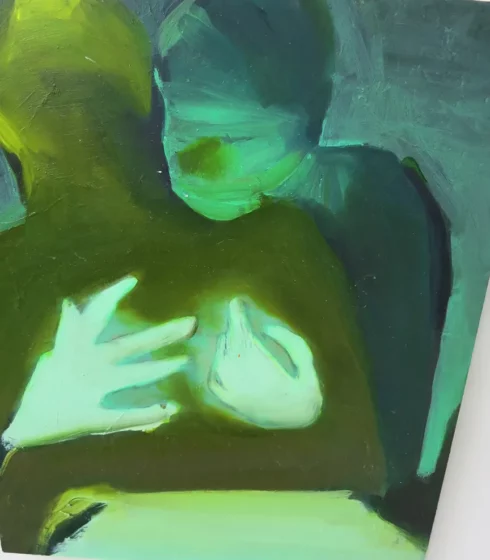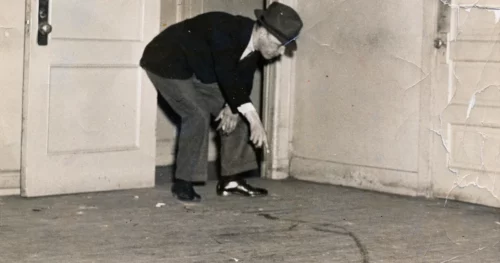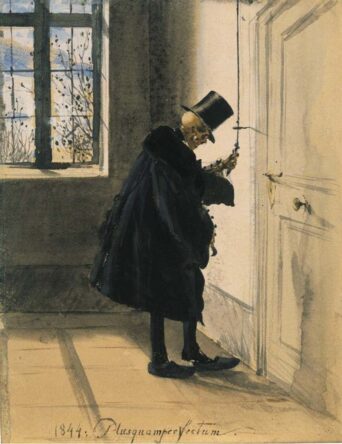
Elizabeth Glaessner
“The wing of the Angel of Death brushes against me, and the systole of my soul inundates the depths of my spirit with the blood of divinity … our elaborate human lineage is no more than a doomed procession of phantoms trooping from nothingness to nothingness …. If we are all to die altogether-what is the point of everything! Wherefore? It is the Wherefore, the Wherefore of the sphinx, that corrodes the marrow of our soul and that is the begetter of the anguish which stirs our love of hope …. And so we sing dirges to death, the never-ending respite, simply from fear of it, and call it a liberation. “
Miguel de Unamuno (The Tragic Sense of Life)
“It is quite impossible for a thinking being to imagine nonbeing, a cessation of thought and life.”
Goethe (Conversations of Goethe with Johann Peter Eckermann)
“…in the unconscious every one of us is convinced of his own immortality.”
Sigmund Freud (Thoughts for the Times on War and Death, 1915)
“Without death men would scarcely philosophize…”
Arthur Schopenhauer (The World as Will and Representation Vol.1)
“To know death is not to know it.”
Liran Razkinsky (Freud, Psychoanalysis, and Death)
“But of the tree of the knowledge of good and evil, thou shalt not eat of it: for in the day that thou eatest thereof thou shalt surely die.”
Genesis 2:17
There is an obsession in contemporary western society with ‘identity’. Collins Dictionary defines the word two ways.
First (countable) “Your identity is who you are.” And second (variable): “The identity of a person or place is the characteristics they have that distinguish them from others.”
Cambridge Dictionary defines it as “a person’s name and other facts about who they are.” Dictionary dot com has “the condition of being oneself or itself, and not another.” And so on. Its one of those words. The pronoun ‘who’ is involved in a lot of these definitions. It precedes a clause giving more information about the person or persons or thing being defined.
As a boy (and I think most children experience this questioning) I was deeply interested in the idea of death. Why was this frightening? The frightening part, so I told myself, was the loss of this identity thing. I wrote a monologue about this in Dogmouth. Trying to imagine just ceasing to exist was terrifying. But also difficult. Just YOU are not there anymore. One moment you ‘are’ there, and the next you are not. Nothingness. Non identity is the core terror of existence. One does not fear death so much as fear the end of identity. And that is what one usually fears death ‘is’, death is the great nothing.
It seems surprising, given that everyone dies, that so relatively little has been written about the subject. There are a lot of ‘Near Death Experience’ accounts and writings, but most veer into the pseudo science of paranormal studies. Some dig into the neuroscience of death, which is, I admit, interesting, but suffers from that quality of scientism that infects so much of contemporary research. And you have a lot of religious writing on the subject of what happens ‘after’. No matter how hard one tries to imagine death one is always present in the imagining. A spectator at one’s own funeral in a sense. THAT is the terror. You are not there.

Sarah Morris
Both the NDE research and the purely neurobiological share problems of incompleteness. Or perhaps they are just inconclusive. Because the real issue is what happens after our clinical death? Once the synapses stop firing, what happens to our identity?
Now one might ask why I am writing about this just now. And I have no real answer other than when you reach the age of 73 you find more and more friends have died. Also, since I personally had this cardiac event (not a heart attack but an arrhythmia that had become problematic due to age and other issues). The point is that I fell over at a chess tournament but was lucky that two chairs down was a chess playing doctor. And a hospital across the street. And I was shocked back into a normal heartbeat. I was sort of dead for around two minutes. Thats one obvious reason. But the second is linked a sense I have of metaphoric death or soul death as it seems to exist for so much of humanity at the moment.
I was also very sick as a child. Very. And I spent a year in the hospital (well, ten months) when I was eleven. I had a gall bladder removed (gangrene) and complications from that, including a weeks coma. I actually came to like the hospital. (LA Children’s Hospital) and as an only child I think this year shaped much of my solitary nature. To this day I dislike ‘plans’. I like an open ended day (or week or decade) ahead of me. How is that related to this topic you might ask. I am not sure, but I think those who were ill as children, especially the only child, carry a certain heightened sense of mortality with them.

Wade Guyton
“The real question, however, is a metaphysical one. It is the old question about the justification and sense of the artes liberales. What are ”liberal arts”? Thomas Aquinas provides some conceptual clarification in his Commentary on Aristotle’s Metaphysics: ”Every art is called liberal which is ordered to knowing; those which are ordered to some utility to be attained through action are called servile arts. { } ‘Liberal arts’, therefore, are ways of human action which have their justification in themselves; ”servile arts” are ways of human action that have a purpose outside of themselves, a purpose, to be more exact, which consists in a useful effect that can be realized through praxis.”
Josef Pieper (Leisure: The Basis of Culture)
Stephen Cave, in his book Immortality, suggests there are four narratives that all societies and cultures employ to deal with death. The first is science finding a way to stay alive forever (or at least a very long time). The second is resurrection. The idea ‘we’ return. The third is the ‘soul’ narrative, that while our bodies may perish, something else continues on. And then there is what Cave calls the ‘legacy’ narrative.
“The Greeks believed that culture had a permanence and solidity that biology lacked; eternal life therefore belonged to the hero who could stake a place for himself in the cultural realm. Today we seem to be as desperate for celebrity as Achilles was for glory; the competition for cultural space is as hot as ever. Some of us also leave a more tangible legacy than our reputations alone: children. Our genes have been called immortal because they stretch back millions of years in a traceable line to the very beginnings of life, and if we are lucky will also continue into the distant future. Or perhaps, as some claim, our legacy is to have been part of life on earth—part of Gaia, the superorganism that will remain long after we individually are gone, or even part of the unfolding cosmos itself”
Stephen Cave (Immortality)
Cave is a sort of popular philosopher, for lack of a better word, and while his book is quite enjoyable and even insightful, it is finally problematic for the very reasons I just stated. The popular is always reductionist. But these four narratives that Cave describes, are useful in their way.

LAPD crime scene photograph (Hollywood, July 30th, 1953)
“The problem with speaking of death as a negation can be shown from a different angle: what actually, we may ask, is negated by death? Death might be a negation of life, but do we have a representation of life in the unconscious, or even the conscious mind, that can be negated by it? Alternatively, we can speak of death as negating who we are, the life that is ours, our identity—but do we have such an unconscious representation of ourselves, and will it not, if we posit such a representation, necessarily include a reference to time (itself, according to Freud, absent from the unconscious)?”
Liran Razinsky (Freud, Psychoanalysis and Death)
“It is ultimately the fear of death which is behind our cravings to possess, and incorporate, behind our greed and sadism and the predatory aspects of our modes of life. “
Joan Riviere (Developments in Psychoanalysis 1952)
The fear of death in what Cave calls the ‘legacy’ narrative is seen in things like inheritance. And much of the legacy idea is Roman in origin. But this is the repressed fear. There is another less repressed fear that takes the form of fear of women. Misogyny was seen at the Olympics with biological males beating up women. And applauded as a virtue.
“Man’s nausea, fear, disgust, and repudiation of the body and sexuality can only be a reaction to his own sense of mortality, so misogyny can be seen as an explicit reaction formation to fear of death.”
Jerry S. Piven (Death and Delusion)

Paul Gauguin (The Spirit of the Dead Keep Watch, 1892)
There is something in contemporary society, in the West, that seems to be an emergent Nazism, decades in hiberation. And this Nazism is deeply misogynist. This was the Klaus Theweleit thesis in his Male Fantasies. The unmasked Zionist death cult is today a shining example of the mortal terror death holds, and the deforming terror of the female. In fact Piven, references Theweleit and then comments:
“This recalls the scene from Yukio Mishima’s (1956) novel The Temple of the Golden Pavilion, where a young acolyte steps on the belly of a prostitute. Though initially inhibited, the acolyte gradually begins to enjoy the act of crushing the site of her femininity and fertility, rendering her helpless, humiliated, and injured at the locus of her sexuality. Such violence eradicates the fear of being castrated, of effeminacy, one’s own loathsome desire for that beauty which is a disgusting and castrated mass of bloody tissues and amniotic floods. It punishes women for concealing this revolting decay beneath their seductive eroticism. In the minds of such perpetrators, transforming woman into cadaverous jelly is the vengeful gratification of punishing her for what she really is: “Once she … is reduced to a pulp, a shapeless, bloody mass, the man can breathe a sigh of relief” (Theweleit, 1977). The “lascivious delight” and “pleasurable perception of women in the condition of ‘bloody masses'” pervades Nazi writings and represents the attempt to master dread, disgust, and fear of the feminine. “
Jerry S. Piven (Ibid)
I remember that as a young child I had a repeating dream. It came with the onset of fever. Later it would occasionally appear without any accompanying illness. The dream was of a room, oddly lit by an indeterminate source, but without shadows. The primary characteristic of this room was that I could not see, in my dream, the walls to either side. In a sense I was looking at a stage. But I really did not see any floor either. The back wall was ochre and seemed to have, at least sometimes, windows. The blinds were drawn. And stretched tautly (!) across this dream stage was a clear line, like a fishing line. I always described it as fishing line. And balanced, precariously, on this taut line was a giant rock. The rock was brownish, light brown, and appeared like volcanic rock. I sensed it must be light in weight. And it teetered. And there was a horrible sense of foreboding associated with the rock falling from its delicate balance on the line. And the rock was enormous. Impossibly big, in fact. Often the walls undulated. I do remember if my fever was high that the walls undulated more. Often creeping in. The room, or stage, shrinking.
And that was it. Nothing ever happened. The rock never fell. I probably had this dream ten times. Perhaps more. It stopped by the end of my hospital stay at age eleven.

Yto Barrada, photography.
The genocide in Gaza is so obviously akin to other societal sicknesses such as the 14th century witch burnings across Europe. The religious is both an actual force in such depravity, but also cover for materialist motives of greed and envy. The Church in the 14th century feared the organization of women in guilds and so nurtured a hysteria of fear. With Zionist rabbis the mortal terror is of women, but there is a partly conscious materialist motive which is, like the 14th Church, oddly close to the repressed causal factors. Zionists must murder children and mothers. For they will give birth to more of the same. The sense of being Chosen and a super race, like with Hitler and the Third Reich, justification for the mortal terrors of death and castration, and the parallel avoidance of the moist and fecund. That so many child molesters live in Israel is hardly accidental.
“The fortress of the body, the primary base for narcissistic operations against the world in order to insure one’s boundless powers, crumbles like sand. This is the tragic dethroning of the child, the ejection from paradise that the castration complex represents. Once he used any bodily zone or appendage for his Oedipal project of self-generation; now, the very genitals themselves mock his self-sufficiency. “
Ernest Becker (The Denial of Death)
“Patient was recalling how he and his brothers used to play ‘hide and-seek’ on winter evenings, with their father, all over the house, which was a large country mansion with many stairs, passages and attics. The father was an active powerful man, much admired and envied by the patient, a delicate feeble boy. Patient recalled that he had always had a belief, which he thought was shared by his brothers, that the father had an unfair advantage over them, partly on account of his agility and strength, but chiefly on account of his supposed use of a secret staircase, which the boys were not allowed into and had never . This was supposed to lead into an attic on an upper floor and accounted for the father’s sudden appearances and rapid movements about the house. I pointed out to the patient the symbolism of the house, of which the father had such secret and familiar knowledge and use, and he then further recalled, to his own amazement, that according to the childish fantasy these stairs were supposed to lead out of his mother’s bedroom, either from inside a cupboard or from some concealed opening. ‘None of us ever knew where it went up from.”
Joan Riviere (Collected Papers)

Imran Qureshi
Now, at the very deepest level of the unconscious I suspect there exists something that might be the source of deepest fears and terrors. Thomas Ogden was a clinical psychiatrist who borrowed from both Bion, but also Anzieu, Bick, and Tustin:
“The autistic-contiguous position is a primitive psychological organization operative from birth that generates the most elemental forms of human experience. It is a sensory-dominated mode in which the most inchoate sense of self is built upon the rhythm of sensation particularly the sensations at the skin surface. The autistic-contiguous mode experiencing is a presymbolic, sensory mode and is therefore extremely difficult to capture in words. “
Thomas H. Ogden (The Primitive Edge of Experience)
This has deep political implications, too. The rise of autism today has elicited a host of theories and explanations. I am coming to feel strongly that habituation to screens and digital tech is a primary problem. But that is insufficient. For why are there so many screens, why is there digital tech even? The autistic-contiguous position is that layer of very early organizing that relates to being held and nursing. The infant cannot process more (certainly premature babies must be carefully limited to sensory input) and will develop rigid containing mechanisms.
“These experiences are “object-related” in a very specific and ‘very limited sense of the word. The relationship to the object in this mode is certainly not a relationship between subjects, as in a depressive mode ; nor is it a relationship ‘between objects, as in a paranoid-schizoid mode . Rather, it is a relationship of shape to the feeling of enclosure, of beat to the feeling of rhythm, of hardness to the feeling of edgedness. { } Early experiences of sensory contiguity define a surface (the beginnings of what will become a sense of place) on which experience is created and organized.”
Thomas H. Ogden (Ibid)

Luc Tuymans
The adult who suffers from some degree of autistic-contiguous infant life is going to be severely limited in their capacity to receive love and affection. The deficit in their parenting, the time holding or caressing, is certainly a problem in later ability to discriminate input, both skin sensation, and likely everything else. This leads back to the hardness, the carapace like quality of the hyper masculine today. And this fear of the moist and undifferentiated. The female’s blurred boundaries. The comfort of ‘stiff’ as opposed to yeilding (and surrender).
A race between Trump and Harris could only be the product of a patriarchy. A man terrified of women, with a fake tan, and a party girl promoted by men throughout her life. But there is one other aspect of what Ogden is describing, and which again relates to this idea I have posited about theatre and a primal space.
“Meltzer (Meltzer et al., 1975), building upon the work of Bick (1968), introduced the term adhesive identification to describe a form of identification more primitive than either introjective or projective identification. In an autistic-contiguous mode (which Meltzer refers to as the “world of two-dimensionality”… { } adhesive identification includes imitation, mimicry, and clinging forms of sensory connectedness to an object that “can hold [one’s] attention and thereby be experienced, momentarily at least, as holding the parts of the [sensory-dominated] personality together.”
Thomas H. Ogden (Ibid)
It was Bick who coined the term ‘second skin formation’. A self protective attempt to create contiguity and a sense of one’s own surface. Hospitalized patients, as well as newborns, and even animals in distress are often wrapped in sheets, snugly, to foster a defense against the formless dread and terror of annihilation.
“…the development of infantile eczema that Spitz (1965) understood as a psychosomatic disorder resulting from insufficiency or inadequacy of parental holding in the first weeks and months of life. The continual scratching (often leading to the necessity of
wrapping the infant’s hands in gauze to prevent severe skin damage and infection)is understood from this perspective as the infant’s desperate attempt to restore (through heightened skin sensation) a surface by means of which the terror of leakage and of falling into shapeless space is allayed.”
Thomas H. Ogden (Ibid)
One of the questions raised by Razinsky and others is the lack of direct analysis of Death in psychoanalysis. Freud actually probably repressed it, to some degree, and while much was written on the Death Instinct, or Death Drive, there is surprisingly little on the role of Death in the unconscious.

St James the Greater, by Gil de Siloe, 1493.
Jerry S. Piven (Ibid)
The fear of unknowing.
“The tradition has coined a formula for this personal sealing of earthly existence. It is described as the termination of the status viatoris. Viator means wanderer, walker, wayfarer, pilgrim. The last term has acquired a special meaning and became a familiar part of religious parlance. We speak of the “pilgrimage” of this earthly life. This is a perfectly honorable and legitimate use of the word, to which no serious objections can be raised. However, certain rather melodramatic overtones have become associated with this usage, overtones which may blur the precise meaning of this important term, or even cause us to brush it aside. In reality the concept of status viatoris involves nothing sentimental, nor even anything distinctively religious or theological. What is meant, rather, is that man, as long as he exists in this world, is characterized by an inward, as it were ontological quality of being on-the-way to somewhere else. The life of historical man is structured as becoming, “not-yet,” hope. Granted, we have countless choices on our “life’s journey.” We can make detours and take byways; we can stand still; perhaps also we can, in a certain sense, go backward. Above all we can progress in the true direction. Only one alternative is barred to us, that of not being en route at all,of not being ‘on the way’. { } And Sartre strikes precisely the same note when he says that our life is “made up not only of waitings but of waitings which themselves wait for waitings.” As for Ernst Bloch’s fascinating though rather perplexing philosophy of hope and the future, it certainly makes one point with complete clarity: “The real thing, in man as in the world, is impending, waiting”; man is something “not yet at all present, and for that very reason he has history.”
Josef Pieper (Death and Immortality)

Weegee, photography.
“For when I say darkness, I mean a lacking of knowing: as all that thing that thou knowest not, or else that thou hast forgotten, it is dark to thee; for thou seest it not with thy spiritual eye. And for this reason it is not called a cloud of the air, but a cloud of unknowing, that is betwixt thee and thy God. ”
The Cloud of Unknowing (1300s. Author Unknown)
Pieper above is touching on the profound importance of narrative. That we all must ‘move’ toward something. Pilgrimage. Exile, homesickness. A sense of place. Western society today is saturated with what is termed ‘mental health crises’. And in particular depression. And the majority of depressive conditions are linked to loneliness. And this is very close to childhood separation anxiety. For the child, separation is a kind of death. A fear of annihilation. All stories are about homesickness. All stories are crime stories.
“Freud’s reading of culture in this text is nearly identical to Rank’s (1939) interpretation of civilization as founded on the wish for immortality. When civilization protects against death and insignificance, it is also creating a structure which will provide a sense of meaning and importance to its achievements. This is why Brown (1959) described the Egyptian pyramid as a denial of death, because it is an archetypal monument to human existence which will not decay, which reaches up into the sky and cosmos and declares that human life participates into that timeless cosmic vastness, and will not erode or disappear. Thus Freud writes not only of religious illusions in this text, but also of political, cultural, and erotic illusions . Both the social and individual search for significance implies the need to be somebody as against the dread of nonbeing threatened by mortality. Freud is suggesting that ideological illusions, the search for significance, and the lies of self-regard, are warding off not just genuine threats to life, but symbolic threats as well.”
Jerry S. Piven (Ibid)

Adolph Menzel (1844)
So in a sense psychoanalysis does address death. It simply cannot address it directly and perhaps that is appropriate. For this is the finally the fear of unknowing. Of helplessness. The terror of dying is the terror of dying alone. For we all die alone. Nobody can come with us. Talk about death is almost always full of platitudes and cliches. Headlines suggest so and so died peacefully surrounded by family and friends. Except he or she still died alone. In an instant that person was no longer there. If you have watched a birth there is the same uncanniness. Suddenly someone else is in the room. Three people but now a fourth (etc). An infant. And part of the uncanny is that the infant has arrived prematurely. The infant cannot talk. Can barely see. Is totally dependent. Existence is, then, uncanny at its core. Hence so is identity. And one of the truths of death, of its representation in our lives is that direct description seems to fail for a variety of reasons having to do with limitations in language, and with symbolization. Death does appear, though, in sublimated form nearly everywhere.
“In studying the phenomena which testify to the activity of the destructive drive, we are not confined to observations on pathological material. Numerous facts of normal mental life call for an explanation of this kind, and the sharper our eye grows, the more copiously they strike us.”
Sigmund Freud (Analysis Terminable and Interminable)
“On this view, life and death drives are not conflictual forces, but the death drive is an organising principle and ethical imperative. As such it structures the psyche, rather than being its pathological distortion. The urge to return to an inorganic state (to die) and the drive to return to an earlier state (the conservative drive) appear in both Eros and Thanatos as two types of repetition. Viewed as repetition, death is not a simple opposition or negation of life, but a fundamental element that constitutes life’s regularity (Deleuze, 1994). On this view, the death drive regulates repetition, which in turn forms the basic patterns of life. Eros manifests itself through repetition while the death drive is what gives Eros its repetition. This breaks down even further the pseudo-symmetry between Eros and Thanatos that stands at the basis of Freud’s dualistic model, and gives the death drive a regulative function.”
Havi Carel (Life and Death in Freud and Heidegger)

Lawrence Calcagno
The thing is, regards psychoanalysis, the Death Drive, or Death Instinct (more on that in a minute) is that Freud’s idea of the death drive is not mutually exclusive with other forms of dying.
“Absent from every unconscious, death is perhaps rediscovered in the unconscious as the most radical – but also most sterile – principle of its logic.”
Jean Laplanche (Life and Death in Psychoanalysis)
Laplanche has emerged over the last decades as by far the most important psychoanalytic thinker of the last thirty years (he died in 2012). I think his lack of a wider audience is that his style is quiet and his thinking very precise and careful. It is bold, certainly, when necessary, but he was not himself flamboyant or controversial. I digress.
James Grotstein has a series of papers related to schizophrenia. And he employed the term ‘black hole’, an experiential term used by patients in primitive mental disturbances to designate a catastrophic discontinuity of self. A falling into a void or abyss. (the term was first used by British soldiers kept captive in claustrophobic conditions in India during the Nabob revolt). One of the primary experiences is the feeling of having no floor. Grotstein writes it “represents the ultimate traumatic state of disorganization, terror, chaos, randomness, and entropy.” (Contemporary Psychoanalysis Vol 26).
This is the most apocalyptic expression of the death drive.

Federico Barocci (Florence 1590)
“The death instinct is our preparedness to anticipate and therefore to adapt to (regulate) this ultimate horror. Its ultimate significance lies “in its function as supplying signal anxiety to detect, not only dangerous, death-dealing predators both outside and inside, but also to detect the emergence of unmodulated meaninglessness and nothingness presenting as disintegration of the self from within.”
James Grotstein (Ibid)
I note that my recurring dream of the giant rock on the taut fishing line also was an image of an enclosure with no floor.
Now, here it seems important to note that the closer one gets to some kind of grasp or purchase on the idea of Death, the further into severe mental disturbances one gets. And this is odd, in a way, I think. We all die and at first glance we should all be discussing and theorizing about death pretty much all the time. And as Bukowski noted (the poet) this should make us all love one another. Alas, it does not. As Razinsky notes, if the death drive is Freud’s answer to the question of death, it is also among the least accepted or popular of Freud’s theories. It is hard not to see an avoidance here.
This derealization of the object world (per Grotstein) is the final mortal terror one can experience. Kristeva termed it *abject*. But back to the presence of death in the everyday, for this is a hugely neglected area of investigation. Yes, one can see the presence of castration anxiety, or of various compulsions that have their basis in morbid conditions. I would argue, though, that the entire presence of *entertainment* is an expression of death. But how can one say that, exactly? I will explain, in a roundabout sort of way…

Dexter Dalwood (Sharon Tate House, 1998)
“Freud emphasizes repeatedly in *Totem and Taboo* (1913) that death is the most horrific fate among tribespeople, and that complex prohibitions and rituals are invented so as to avoid, contain, and ward off death…It would seem that the fear of death is a horrific preoccupation that shadows the primitive community and suffuses every action, practice, boundary, belief, and object . . . For Freud, however, this is all manifest illusion, projection, obsessive fantasy … Beneath the taboo is repressed desire, and the desire is repressed for fear of being killed by the king, or a ghost, or a god… The fear of death is not apprehension
over the thought of nonexistence, nor of being killed by an enemy or carnivorous beast…, but guilt over illicit death wishes and the terror of reprisal. …. Thus for Freud beneath manifest terror lurks the fear of being murdered by the parent.”
Jerry S. Piven (Ibid)
This is quoted by Razkinsky. He writes, then; “Thus, again, fear of death is concretized (reduced to the fear of the dead), rendered active and seen as a derivative or a byproduct of the death wish. The threat looms up from a concrete source: having wished for the death of the dead person, one now fears his revenge. It is a threat of wrathful murder, and not of death as an existential given or an impersonal force.”
Liran Razkinsky (Ibid)
Grotstein notes that across myriad disciplines and religions there is similar attempt made to grasp this ephemeral concept of identity. From Meister Ekhart or Zohar or the Gnostics.
“Subjectivity is the quintessence of Platonic ineffability; that is, we can get only a glimpse of the shadow that the subjective “I” casts on the walls of the cave as its “selfness.” In his attempt to clarify the concept of subjectivity, Descartes proffered the idea of subject and object, a dichotomy that was recognized and respected by Aristotle, St. Augustine, Kant, Fichte, Schelling, Hegel, Schopenhauer, and Brentano. St. Augustine, according to Modell (1993), defined self-consciousness as a “private self” and viewed this inner or private self as a source of spirituality and authenticity. Kant (1787) spoke of the “transcendental subject” as the “I who thinks,” yet he distinguished between a “metaphysical self” and a “personal self,” according to Cassam (1997). (This distinction seems to be in line with my categories of the Ineffable Subject and the Phenomenal Subject, respectively.) However, Kant equated the transcendental with a priori capacities and distinguished it from the “transcendent” (speculative). Husserl (1931, 1962) posited the concept of the “transcendental Ego,” which is not a part of this world, in contrast to the idea of the man who is capable of self-experience in everyday life. I take the former to be Husserl’s way of designating what I am calling the Ineffable Subject and the latter to be the Phenomenal Subject of quotidian experience. Wittgenstein (1921) argued that the philosophical self is not the human being, not the human body or the human soul, with which psychology deals, but rather the metaphysical subject, the limit of the world—not a part of it.”
James S. Grotstein (Who Is the Dreamer, Who Dreams the Dream?)

Billy Al Bengston (1968)
There is a presence of death in the American electoral system today. Biden is a corpse, perhaps literally. In the cackling obscenity of Kamala Harris (her open mouth) is something of a de-realization of otherness. Trump is Death, a walking taboo. Israel is Satanic, and probably suffering collective abjection. But the actions of the IDF and settlers increasingly feels like that gang of serial murderers and torturers in Chicago in the 80s (The Chicago Rippers). But death is also, literally, the network comedies each year, it is the creepy figure of Tom Hanks, and his oddly unconvincing representation of being alive. (see Von Kleist on Marionette theatre).
https://15orient.com/files/kleist-on-the-marionette-theatre.pdf
It is drag queen story hour and it is Macron and his wife. To look at Keith Starmer is to experience the uncanny valley. Tim Walz is perfect for Kamala, they have the same gaping maw of a mouth. A black hole. When they open their mouths wide, the air is sucked out of the room, in fact the room itself shrinks. It is the white body of Elon Musk, and it is every cop in America, I think. Death is the visor being pulled down on the motorcycle cop’s helmet.
If you see the child slaves digging rare earth minerals in Congo, this is not death. This is a horror but it is a horror that potentially we can change. Revolution changes things. Dinner with the Macron’s will always be dinner with the Macrons.
“Life and death are interdependent; they exist simultaneously, not consecutively; death whirs continuously beneath the membrane of life and exerts a vast influence upon experience and conduct.”
Irvin Yalom (Life Death and Anxiety)

Diary of a Country Priest (dr. Robert Bresson, 1951)
Morbidity is everywhere. Perhaps in a sense western society, and even possibly most of the planet, infected by the culture of the West, is now suffering this sense of a *black hole*. An emotional void. Disequilibrium.
“The idea of the subject seems in retrospect to have been implied in Freud’s (1905b) theory of infantile sexuality, the function of the libidinal drives, and the action of cathexis. One also sees a prefiguration of the psychoanalytic subject in the works of Melanie Klein when she focused on the clinical construct of the “infant of analysis,” the model of a virtual infant in the analysand’s unconscious, which reveals mental pain to the analyst during free association. Furthermore, the concept of the subject is implicit in Klein’s (1940) conception of the depressive position, in which infants begin to replace their narcissistic image of the object in favor of one emphasizing mother’s separateness, wholeness, and uniqueness. ”
James S. Grotstein (Ibid)
A few other partial notes … this also from Grotstein….
“Subjectivity has also begun to surface in postmodern psychoanalysis as narcissism, in the analysand, and as countertransference, in the analyst. It is implicit in the new concept of intersubjectivity and has reached its apotheosis in Ogden’s (1994a, 1997) concept of the “intersubjective third subject of analysis” (which I call the covenant), a concept that itself follows upon the earlier works of Jung (1966) and Tresan (1966), both of whom posited the notion of the subjective third in the transference situation. Ogden’s “analytic thirdness” is the dialectical chimera, as it were, of the intersubjective interaction of the analysand’s and analyst’s respective subjectivities; that is, the quality of subjectivity inheres not only in each of the two participants but also in the relationship itself. In other words, the interrelationship is itself a subject. I myself regard the subjugating subjective third subject as a twinship of subjectivities in which that of that of the analysand normally predominates over the subjectivity of the analyst so that the former can direct the analytic play, as it were, since only the analysand’s subjectivity knows where the body is buried, so to speak.”
James Grotstein (Ibid)
Artists should intuit most of this, I think. For this is where mimesis enters, and where the practice of art, of creativity, of creation (including having children) intercedes. At one end of the legacy of Englightenment thought is CERN, or Pfizer Pharmaceuticals, then at the other end is Diary of a Country Priest, or Gospel According to St Mathew, or Dostoyevksi and Melville.
“According to Ogden’s (1994, 1997) theory of thirdness, relationships between people are mysteriously controlled by a third, intangible relationship, a haunting subjectivity that eerily controls and mediates the felt experiences and motivations of both parties without either being certain of the true origin of motivation or experience. We are determined even as we believe that we determine. Similarly, Lacan (1966) said that the ego speaks and does not know that it is spoken-by the Other through it. ”
James Grotstein (Ibid)
To donate to this blog, and to the Aesthetic Resistance podcasts, use the paypal button at the top. Or on Substack use Stripe.

This is a brilliant essay. I’ve only got about half way through yet but want to add these observations prompted by the above:
My own version of this fear of death as non-being came in the form of musing on how death – as loss of consciousness – must be like falling asleep which we do every night and is therefore not to be feared. And even the thought of a vast amount of time passing whilst unconscious is not fearful since there can be no sense of time without consciousness. BUT these periods of unconsciousness only become intelligible when we wake up. If we DON’T wake up then our thoughts on this scenario give out completely. We are confronting something unimaginable.
Philip K Dick had an interesting theory about the Nazis – he felt that since they felt terrified by their impotence in stopping or even retarding death, they strove to give themselves the only sense of power available: if they couldn’t stop or slow down death, they could at least speed it up and thus grant themselves a spurious sense of “godlike power”.
This fear of the feminine as a fear of the sheer viscerality of life may be more effectively echoed in the writings of H P Lovecraft than anywhere else. His nightmares always seem to revolve around a kind of biological chaos – those frightful hybrids of human and amphibian, those dense tentacled undersea monstrosities – Stephen King once credibly referred to Lovecraft’s “Cthulhu” as a “vaginal symbol”.
One of Lovecraft’s apparently minor but possibly most significant tales is “Arthur Jermyn” in which an aristocrat finds that he has been descended from the mating of an ancestor and a mysterious white ape recovered from Africa. But what is most curious about this tale is a suggestion that the white ape is part of a degraded species from which the entire human race is descended!
The odd thing is that Lovecraft, an aggressive atheist, presumably took for granted the theory of evolution which presumes that humanity evolved from apes anyway. That the human race may have been the product of some “step backwards” is curious – and obviously implies that there must have been some more advanced “humanity” at one point (angels?).
There is a lack of coherence here and even a hint at some religious outlook involving a “fall”.
But it is interesting that Lovecraft – one of the most UNsensual people who ever lived and who prided himself on his “rationality” – had an output full of “pathological infantile” imagery. (The description is Michael Moorcock’s.) HPL was also a proto-fascist. And of course a racist.
In a similar – if less extreme – vein, someone once said that the only erotic entity in the whole of Tolkien’s Lord of the Rings was the giant spider Shelob. Shelob is a kind of (marginally) watered down Cthulhu. This giant spider – significantly a “she” – is conveyed by the same gooey slimy imagery favoured by Lovecraft.
What also occurs to me is Jung’s claim that Hitler never developed a healthy relationship to his anima (the image of the female in a male). This results – according to Jungian psychology – in a magnification of the anima but with a negative aspect. Jung talks about “the terrifying mother”. He might also have talked about “the witch”, “the crone”, “the enchantress” etc.
It’s as if the potentially positive image of the female within the male mind has been perverted into the aforementioned demonic images. This also most obviously applies to the witch hunts in the past where women were associated with Satan – though that connection was already incipient in The Bible.
The witch-hunting/ Nazi pathology towards women finds an echo in the recent phenomenon of “incels” – those young men who unforgivingly cast themselves in the role of chronic losers forever shunned by women. We can certainly apply the Jungian matter of failing to develop a healthy attitude to the anima in these young men.
Another echo comes from the “transgender community”. Arguably, there has always been a misogyny at the heart of all male impersonators of women. But the “trans” movement seems to me to present something radically new: a sense of female presentation that now takes a belligerently “apocalyptic” tone – as if this is the “final showdown”. We have now gone from men who hate women to men whose hatred of women pushes them to “become women” i.e. to replace women.
In Jungian terms, this male impersonation of women has resulted in something like a move from the psychic realm of the negatively cast anima to concrete individual presentations of actual witches, crones etc. And most significantly, all sense of ACTUAL sexual activity now seems to have been banished completely leaving behind nothing but sheer violence.
I came across this quote right after I read this post: Ehrenreich, Barbara (2018). Natural Causes: An Epidemic of Wellness, the Certainty of Dying, and Killing Ourselves to Live Longer. “You can think of death bitterly or with resignation … and take every possible measure to postpone it… [or] … you can think of life as an interruption of an eternity of personal nonexistence, and seize it as a brief opportunity to observe and interact with the living, ever-surprising world around us.”